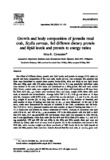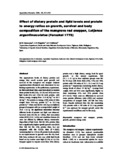| dc.contributor.author | Santiago, C. B. | |
| dc.contributor.author | Focken, U. | |
| dc.contributor.author | Becker, K. | |
| dc.contributor.editor | Chwalibog, A. | |
| dc.contributor.editor | Jakobsen, K. | |
| dc.date.accessioned | 2011-06-22T09:35:50Z | |
| dc.date.available | 2011-06-22T09:35:50Z | |
| dc.date.issued | 2001 | |
| dc.identifier.uri | http://hdl.handle.net/10862/443 | |
| dc.description.abstract | In order to investigate the effect of different protein/energy levels of diets (two commercial and one laboratory) on voluntary feed intake and energy partitioning in tilapia (O. niloticus), 15 fishes with an initial body mass of 33 g were reared individually in respirometric chambers for 42 days and offered 3 diets ad libitum. The protein contents of the diets were 36.1, 33.8 and 36.8% (dry matter base); the energy content 18.9, 18.4 and 19.2 kJ GE/g and 11.7, 10.5 and 15.4 kJ ME/g. The initial body composition and energy content was estimated from a control group. Feed consumption was recorded for each individual fish. Body mass development was monitored weekly. At the end of the experiment, the fishes were sacrificed and their chemical composition (protein as N.6.25, lipid, ash) and gross energy content were determined. To establish energy budgets, ingestion (I) was calculated from feed intake, retention (P) from accretion in the carcass, heat production (R) from oxygen consumption (indirect calorimetry) and apparently non-utilized energy (faecal and non-faecal losses, U) by difference from energy ingestion.
In the beginning, food consumption amounted to ~5% body mass equivalent (BME) per day for all groups and gradually decreased to 2.5, 2.8 and 1.6% BME by the end of the experiment. While the food consumption was significantly different between the treatments, there were no significant differences in the body mass development. Average final body mass was 98.6, 93.8 and 103.7 g. Energy retention was 29.7, 29.2 and 44.4% of GE ingested; heat dissipation 32.1, 27.9 and 36.0%; faecal and non-faecal losses 38.2, 43.2 and 19.6%. For all energy budget parameters, values for the laboratory diet were significantly different from those of commercial feeds 1 and 2. Calculation of metabolizable energy from ingested feed revealed no significant differences in the energy uptake, suggesting that the voluntary feed uptake was controlled by the demand for metabolizable energy. The fishes were able to completely compensate for the lower ME content of the commercial feeds by increasing voluntary feed intake. | en |
| dc.language.iso | en | en |
| dc.publisher | Wageningen Pers | en |
| dc.relation.ispartof | In: Chwalibog, A., Jakobsen, K. (Eds.). Energy Metabolism in Animals. Proceedings of the 15th Symposium on Energy Metabolism in Animals, 11-16 September 2000, Snekkersten, Denmark. EAAP Publication No. 103. pp. 181-184 | en |
| dc.subject | Finfishes | en |
| dc.subject | Tilapia culture -- Feeding and feeds | en |
| dc.subject | Food consumption | en |
| dc.subject | Proteins | en |
| dc.subject | Feed | en |
| dc.subject | Nutritive value | en |
| dc.subject | Energy budget | en |
| dc.subject | Body composition | en |
| dc.subject | Tilapia | en |
| dc.subject | Oreochromis niloticus | en |
| dc.subject.lcc | VF SP 247 | |
| dc.title | Voluntary feed intake and energy partitioning in tilapia, (Oreochromis niloticus) fed diets with different protein/energy levels | en |
| dc.type | Conference paper | en |
| dc.citation.spage | 181 | |
| dc.citation.epage | 184 | |
| dc.citation.conferenceTitle | Energy Metabolism in Animals. Proceedings of the 15th Symposium on Energy Metabolism in Animals, 11-16 September 2000, Snekkersten, Denmark | en |



